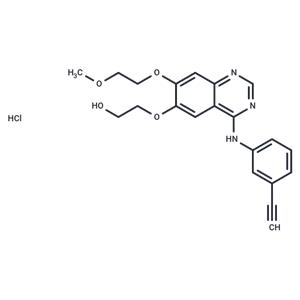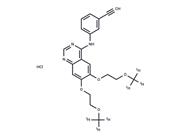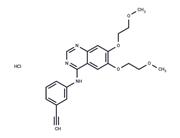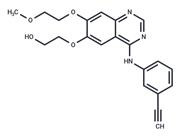| Name | Desmethyl Erlotinib hydrochloride |
| Description | Desmethyl Erlotinib hydrochloride (OSI 420) is an active metabolite of erlotinib which is an orally active EGFR tyrosin kinase inhibitor with IC50 of 2 and 20 nM for human EGFR and EGFR autophosphorylation in tumor cells. |
| Cell Research | Exponentially growing cells are seeded in 96-well plastic plates and exposed to serial dilutions of erlotinib, pemetrexed, or the combination at a constant concentration ratio of 4:1 in triplicates for 72 h. Cell viability is assayed by cell count and the 3-(4,5-dimethylthiazol-2-yl)-2,5-diphenyltetrazolium bromide assay. Growth inhibition is expressed as the percentage of surviving cells in drug-treated versus PBS-treated control cells (which is considered as 100% viability). The IC50 value is the concentration resulting in 50% cell growth inhibition by a 72-h exposure to drug(s) compared with untreated control cells and is calculated by the CalcuSyn software. (Only for Reference) |
| Kinase Assay | Kinase Assays: 96-well plates are coated by incubation overnight at 37 °C with 100 μL per well of 0.25 mg/mL PGT in PBS. Excess PGT is removed by aspiration, and the plate is washed 3 times with washing buffer (0.1% Tween 20 in PBS). The kinase reaction is performed in 50 μL of 50 mM HEPES (pH 7.3), containing 125 mM sodium chloride, 24 mM magnesium chloride, 0.1 mM sodium orthovanadate, 20 μM ATP, 1.6 μg/mL EGF, and 15 ng of EGFR, affinity purified from A431 cell membranes. Erlotinib HCl in DMSO is added to give a final DMSO concentration of 2.5%. Phosphorylation is initiated by addition of ATP and proceeded for 8 minutes at room temperature, with constant shaking. The kinase reaction is terminated by aspiration of the reaction mixture and is washed 4 times with washing buffer. Phosphorylated PGT is measured by 25 minutes of incubation with 50 μL per well HRP-conjugated PY54 antiphosphotyrosine antibody, diluted to 0.2 μg/mL in blocking buffer (3% BSA and 0.05% Tween 20 in PBS). Antibody is removed by aspiration, and the plate is washed 4 times with washing buffer. The colonmetric signal is developed by addition of TMB Microwell Peroxidase Substrate, 50μL per well, and stopped by the addition of 0.09 M sulfuric acid, 50 μL per well. Phosphotyrosine is estimated by measurement of absorbance at 450 nm. The signal for controls is typically 0.6-1.2 absorbance units, with essentially no back ground in wells without AlP, EGFR, or PGT and is proportional to the time of incubation for 10 minutes. |
| In vitro | OSI-420 is the major metabolite of Erlotinib in human plasma. Erlotinib disappearance from plasma after a short IV infusion is biexponential with a mean terminal half-life of 5.2 h and a mean clearance of 128 ml/min per m(2). OSI-420 exposure (AUC) in plasma is 30% (range 12-59%) of erlotinib, and OSI-420 clearance is more than 5-fold higher than erlotinib. Erlotinib and OSI-420 are equipotent, and the combined concentrations of erlotinib + OSI-420 achieved in the CSF exceeded the IC50 (7.9 ng/ml or 20 nM) for the EGFR tyrosine kinase inhibition in intact tumor cells. [1] Erlotinib potently inhibits EGFR activation in intact cells including HNS human head and neck tumor cells (IC50 20 nM), DiFi human colon cancer cells andMDA MB-468 human breast cancer cells. Erlotinib (1 μM) induces apoptosis in DiFi human colon cancer cells. [2] Erlotinib inhibits growth of a panel of NSCLC cell lines including A549, H322, H3255, H358 H661, H1650, H1975, H1299, H596 with IC50 ranging from 29 nM to >20 μM. [3] Erlotinib(2 μM) significantly inhibits growth of AsPC-1 and BxPC-3 pancreatic cells. [4] The effects of Erlotinib HCl in combination with gemcitabine are considered additive in KRAS-mutated pancreatic cancer cells. Ten micromolar of Erlotinib inhibits EGFR phospho-rylation at the Y845 (Src-dependent phosphorylation) and Y1068 (auto-phosphorylation) sites. [5] Combination with Erlotinib could down-modulate rapamycin-stimulated Akt activity and produces a synergistic effect on cell growth inhibition. [6] |
| In vivo | At doses of 100 mg/kg, Erlotinib completely prevents EGF-induced autophosphorylation of EGFR in human HN5 tumors growing as xenografts in athymic mice and of the hepatic EGFR of the treated mice. [1] Erlotinib reduces the growth of xenografted human AML cells. [4] |
| Storage | Powder: -20°C for 3 years | In solvent: -80°C for 1 year | Shipping with blue ice. |
| Solubility Information | Ethanol : < 1 mg/mL (insoluble or slightly soluble)
DMSO : 77 mg/mL (185.2 mM)
H2O : < 1 mg/mL (insoluble or slightly soluble)
|
| Keywords | Desmethyl Erlotinib hydrochloride | Desmethyl Erlotinib Hydrochloride | CP473420 | CP 373420 | inhibit | CP-373420 | Inhibitor | Drug Metabolite | CP373420 | CP 473420 |
| Inhibitors Related | Mycophenolate Mofetil | Isonicotinic acid | Gefitinib |
| Related Compound Libraries | Reprogramming Compound Library | Bioactive Compound Library | Cytokine Inhibitor Library | Membrane Protein-targeted Compound Library | Kinase Inhibitor Library | Tyrosine Kinase Inhibitor Library | Inhibitor Library | Bioactive Compounds Library Max |

 United States
United States



